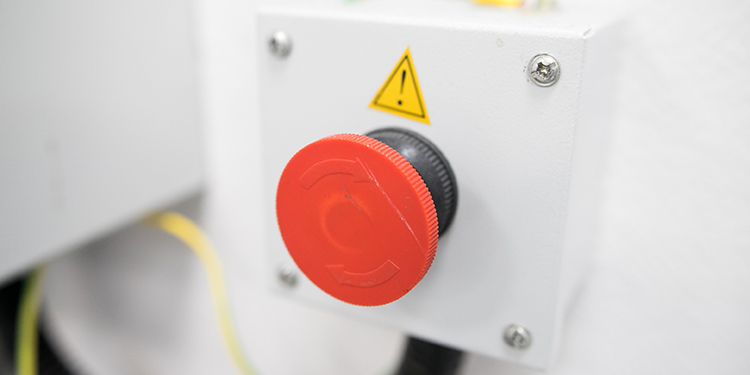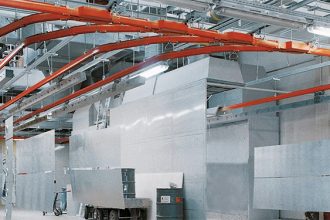Requirements For Safely Cutting Off Crane And Hoist Power In An Emergency

For safety, it is important for personnel to be able to cut the power on overhead cranes and hoists during operation—independently of the operating controls—in the event of an emergency or during a maintenance session. For that reason, an emergency stop (E-STOP) or a safety disconnect switch must be both in place and operational prior to use of the overhead equipment. When engaged, this switch completely blocks the transmission of power from the facility’s source to the crane and hoist in question, ensuring that the equipment cannot be operated.
This component is defined in standards written by both the Occupational Safety and Health Administration (OSHA) and the American Society of Mechanical Engineers (ASME). Although the terminology used is different, the intent is the same:
- OSHA 1910.179(a) (59) defines an “emergency stop switch” as a manually or automatically operated electric switch to cut off electric power independently of the regular operating controls.
- ASME B30.2 defines an “emergency stop switch” as a manually actuated switch to disconnect power independently of the regular operating controls.
- ASME B30.2 defines a “main switch (crane disconnect)” as a switch on a crane controlling the main power supply from the runway conductors.
- ASME B30.2 and 17 define a “runway disconnect switch” as a switch, usually at floor level, that controls the main power supply to the runway conductors.
Because of the criticality of a crane and hoist E-STOP or safety disconnect switch to the overall safety of a facility, there are several standards that detail the requirements for their installation, operation, and function. In addition to the OSHA and ASME standards noted above, these devices are also included in standards by the Crane Manufacturers Association of America (CMAA) Specification No. 70 for Multiple Girder Cranes and Specification No. 74 for Single Girder Cranes, and the National Fire Protection Association’s NFPA 70 National Electrical Code NEC Article 610. These requirements include the following:
- The power supply connected to runway conductors (or any other power supply) must be controlled by either an enclosed switch or current rated circuit breaker that has been located on a fixed structure and can be accessed from the floor. The device should be designed so that it is lockable in the open position.
- In a cab-operated crane, the switch or current rated circuit breaker must be located within easy reach of the operator; in floor-operated cranes the disconnect device must be mounted on the bridge or a foot walk near the runway collectors.
- Remotely operated cranes and hoists must be wired so that if the control signal for any motion stops working the equipment will shut down completely.
- Automatically operated cranes and hoists must be designed so that they shut down completely should any operational malfunction occur.
Although it is a key safety component, the presence of an E-STOP or safety disconnect switch does not guarantee they will be used properly. To ensure that they are, there are a number of recommended best practices surrounding their use. These include:
- Confirm that each E-STOP or safety disconnect switch is easy to identify, locate, and access.
- Train all personnel on the location of each E-STOP or safety disconnect switch and how to use it in the event of an emergency. If there is an overhead equipment failure, the operator may not be able to turn off the power, requiring other floor and maintenance personnel to do so instead.
- In addition to placing the equipment E-STOP on a wall, there should be an additional emergency shut down button on the operator’s controls.
- If it is discovered that the E-STOP switch is not functioning properly, the operator should immediately shut down the crane or hoist and report the problem to the facility operator, owner, or manager.
- The E-STOP should only be used as an emergency device; it should not be used to routinely shut down the hoist or crane.
- Do not permit the operation of a crane or a hoist whose E-STOP is malfunctioning or has been disabled. Doing so could result in a serious accident with a high potential for property damage, injury, or death.
Want more details about the safe operation of cranes? The Crane Manufacturers Association of America (CMAA), offers CMAA Specification 79: Crane Operator’s Manual, and CMAA Specification 80: Below-the-Hook Lifting Device Operator’s Manual.



